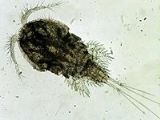
Cyclopoida
Encyclopedia
Cyclopoida is an order of small crustacean
s from the subclass Copepoda
. Like many other copepods, members of Cyclopoida are small, plankton
ic animal
s living both in the sea and in freshwater habitats
. They are capable of rapid movement. Their larval development
is metamorphic, and the embryo
s are carried in paired or single sacs attached to first abdominal somite
.
Cyclopoids are distinguished from other copepods by having first antennae shorter than the length of the head and thorax, and uniramous second antennae. The main joint lies between the fourth and fifth segments of the body.
Cyclopoida contains the following families
:
Crustacean
Crustaceans form a very large group of arthropods, usually treated as a subphylum, which includes such familiar animals as crabs, lobsters, crayfish, shrimp, krill and barnacles. The 50,000 described species range in size from Stygotantulus stocki at , to the Japanese spider crab with a leg span...
s from the subclass Copepoda
Copepod
Copepods are a group of small crustaceans found in the sea and nearly every freshwater habitat. Some species are planktonic , some are benthic , and some continental species may live in limno-terrestrial habitats and other wet terrestrial places, such as swamps, under leaf fall in wet forests,...
. Like many other copepods, members of Cyclopoida are small, plankton
Plankton
Plankton are any drifting organisms that inhabit the pelagic zone of oceans, seas, or bodies of fresh water. That is, plankton are defined by their ecological niche rather than phylogenetic or taxonomic classification...
ic animal
Animal
Animals are a major group of multicellular, eukaryotic organisms of the kingdom Animalia or Metazoa. Their body plan eventually becomes fixed as they develop, although some undergo a process of metamorphosis later on in their life. Most animals are motile, meaning they can move spontaneously and...
s living both in the sea and in freshwater habitats
Habitat (ecology)
A habitat is an ecological or environmental area that is inhabited by a particular species of animal, plant or other type of organism...
. They are capable of rapid movement. Their larval development
Crustacean larvae
Crustaceans may pass through a number of larval and immature stages between hatching from their eggs and reaching their adult form. Each of the stages is separated by a moult, in which the hard exoskeleton is shed to allow the animal to grow...
is metamorphic, and the embryo
Embryo
An embryo is a multicellular diploid eukaryote in its earliest stage of development, from the time of first cell division until birth, hatching, or germination...
s are carried in paired or single sacs attached to first abdominal somite
Somite
A somite is a division of the body of an animal. In vertebrates this is mainly discernible in the embryo stage; in arthropods it is a characteristic of a hypothetical ancestor.- In vertebrates :...
.
Cyclopoids are distinguished from other copepods by having first antennae shorter than the length of the head and thorax, and uniramous second antennae. The main joint lies between the fourth and fifth segments of the body.
Cyclopoida contains the following families
Family (biology)
In biological classification, family is* a taxonomic rank. Other well-known ranks are life, domain, kingdom, phylum, class, order, genus, and species, with family fitting between order and genus. As for the other well-known ranks, there is the option of an immediately lower rank, indicated by the...
:
- Archinotodelphyidae
- Ascidicolidae
- Botryllophilidae
- Buproridae
- ChitonophilidaeChitonophilidaeChitonophilidae is a family of parasitic copepods, containing the following genera:*Chitonophilus Avdeev & Sirenko, 1991*Cocculinika Jones & Marshall, 1986*Cookoides Avdeev & Sirenko, 1994*Ischnochitonika Franz & Bullock, 1990...
- Chordeumiidae
- CorallovexiidaeCorallovexiidaeCorallovexiidae is a family of parasitic copepods. They are associated with corals and, together with members of the family Asterocheridae, dominate their ecological niche in the West Indies; in the Indo-Pacific, they are replaced by the families Lichomolgidae and Xarifiidae.The family contains two...
- Cucumaricolidae
- Cyclopettidae
- Cyclopicinidae
- CyclopidaeCyclopidaeCyclopidae is a family of copepods. It contains more than half of the 1,200 species in the order Cyclopoida in over 70 genera.-Genera:The following genera are accepted as valid:*Abdiacyclops Karanovic, 2005*Acanthocyclops Kiefer, 1927...
- Cyclopinidae
- Enterognathidae
- Enteropsidae
- Fratiidae
- Giselinidae
- Hemicyclopinidae
- Lernaeidae
- Mantridae
- Micrallectidae
- Notodelphyidae
- Oithonidae
- Ozmanidae
- ParalubbockiidaeParalubbockiidaeParalubbockia longipedia is a species of copepod, and the only member of the family Paralubbockiidae. The family is characterised by the ventral position of the fifth legs, the possession of a separate maxillary palp, and the form of the endopods of the legs and antennae. The closest relatives of...
- Psammocyclopinidae
- Pterinopsyllidae
- Schminkepinellidae
- Smirnovipinidae
- Speleoithonidae
- Thaumatopsyllidae

